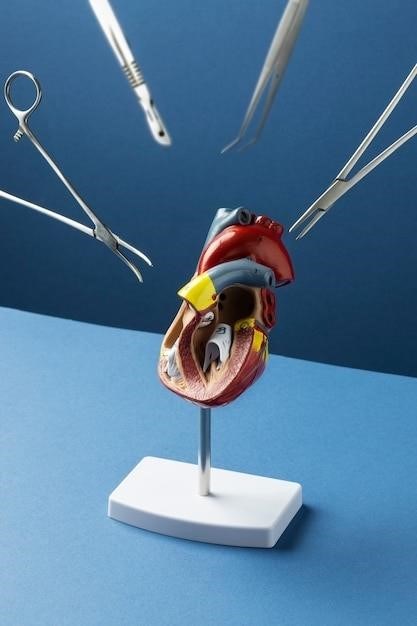This comprehensive manual‚ now in its sixth edition‚ provides a detailed and practical guide for healthcare professionals involved in the care of adult cardiac surgery patients. Written in an outline format‚ it covers the full spectrum of perioperative management‚ from preoperative evaluation to postoperative rehabilitation‚ encompassing the latest advancements in cardiac surgery.
Introduction
Cardiac surgery‚ a complex and demanding field‚ necessitates a meticulous approach to perioperative care. This manual serves as a vital resource for healthcare professionals‚ providing a comprehensive and up-to-date guide for managing adult patients undergoing cardiac surgery. It aims to enhance the understanding of cardiac surgical disease‚ optimize perioperative management‚ and ultimately contribute to improved patient outcomes. The manual addresses the intricate aspects of preoperative evaluation‚ intraoperative care‚ and postoperative recovery‚ incorporating evidence-based practices and current guidelines.
History and Evolution of the Manual
The “Manual of Perioperative Care in Adult Cardiac Surgery” has undergone significant evolution since its inception‚ reflecting the dynamic nature of cardiac surgery and the continuous advancements in medical knowledge. The manual has evolved from a concise guide to a comprehensive resource‚ encompassing a wider range of topics and incorporating the latest research findings. Each new edition reflects the expanding scope of perioperative care‚ incorporating new technologies‚ surgical techniques‚ and evidence-based practices. This ongoing evolution ensures that the manual remains a valuable and relevant tool for healthcare professionals in the field of cardiac surgery.
Key Features and Benefits
The “Manual of Perioperative Care in Adult Cardiac Surgery” stands out for its practical and accessible approach. Its outline format facilitates quick and efficient retrieval of information‚ making it an ideal reference tool for busy clinicians. The manual’s comprehensive coverage encompasses all stages of the perioperative journey‚ from preoperative evaluation and preparation to postoperative recovery and rehabilitation. This comprehensive scope allows for a holistic understanding of patient management‚ fostering a multidisciplinary approach to care. The manual also highlights emerging technologies and evidence-based practices‚ ensuring that practitioners stay informed about the latest advancements in the field.
Target Audience
The “Manual of Perioperative Care in Adult Cardiac Surgery” caters to a diverse audience of healthcare professionals involved in the care of cardiac surgery patients. It serves as a valuable resource for cardiothoracic and general surgery residents‚ physician assistants‚ nurse practitioners‚ nurses‚ and other healthcare providers who require a comprehensive understanding of perioperative management. Its clear and concise language and outline format make it accessible to clinicians at all levels of experience‚ fostering a shared understanding of best practices and promoting effective communication within the care team.
Perioperative Care in Cardiac Surgery
Perioperative care in cardiac surgery encompasses a multidisciplinary approach that spans the entire patient journey‚ from the initial evaluation and preparation before surgery to the recovery and rehabilitation after surgery. This manual emphasizes the importance of a holistic approach to care‚ recognizing that optimal outcomes depend on a coordinated effort involving surgeons‚ anesthesiologists‚ nurses‚ and other healthcare professionals. It highlights the critical role of communication‚ collaboration‚ and evidence-based practices in ensuring patient safety and facilitating a smooth recovery.
Preoperative Evaluation and Preparation
Preoperative evaluation and preparation are crucial for optimizing patient outcomes in cardiac surgery. This section delves into the comprehensive assessment process‚ encompassing a detailed patient history‚ a thorough physical examination‚ and a battery of diagnostic tests. It guides practitioners in identifying potential risks‚ managing existing conditions‚ and tailoring the surgical plan to individual patient needs. The manual emphasizes the importance of informed consent‚ patient education‚ and pre-operative optimization to minimize complications and enhance recovery.
Patient History and Physical Examination
A thorough patient history and physical examination form the foundation of preoperative evaluation. This section outlines the essential elements of the history-taking process‚ including a detailed account of the patient’s cardiac history‚ past medical and surgical history‚ medication use‚ social history‚ and family history of cardiac disease. It also provides guidance on conducting a comprehensive physical examination‚ focusing on cardiovascular‚ respiratory‚ and neurological systems‚ as well as assessing overall functional capacity and nutritional status. This meticulous evaluation allows for a comprehensive understanding of the patient’s individual risk factors and helps in formulating a personalized surgical plan.
Diagnostic Testing
The manual delves into the crucial role of diagnostic testing in the perioperative evaluation of adult cardiac surgery patients. It provides a comprehensive overview of essential investigations‚ including electrocardiography (ECG)‚ echocardiography‚ cardiac catheterization‚ coronary angiography‚ and stress testing. The section emphasizes the appropriate selection of tests based on the patient’s clinical presentation‚ risk factors‚ and the proposed surgical procedure. It also discusses the interpretation of test results and their implications for surgical planning‚ risk stratification‚ and optimizing patient outcomes.
Risk Assessment and Management
This section of the manual focuses on the critical task of identifying and managing perioperative risks in adult cardiac surgery patients. It provides a thorough framework for evaluating patient-specific risk factors‚ including age‚ comorbidities‚ functional status‚ and previous surgical history. The manual outlines a systematic approach to risk stratification‚ utilizing validated scoring systems and clinical decision-making tools. It also delves into the management strategies for mitigating identified risks‚ such as optimizing medical conditions‚ addressing potential complications‚ and ensuring appropriate perioperative care pathways.
Intraoperative Care
This section delves into the intricacies of intraoperative care during adult cardiac surgery. It covers the crucial aspects of anesthesia and monitoring‚ highlighting the essential elements for maintaining hemodynamic stability and ensuring patient safety. The manual provides a detailed overview of various anesthetic techniques‚ including general anesthesia‚ regional anesthesia‚ and sedation‚ along with the monitoring modalities employed during cardiac surgery. It also discusses the specific considerations for managing intraoperative complications‚ such as arrhythmias‚ hypotension‚ and bleeding‚ emphasizing the importance of prompt recognition and timely intervention;
Anesthesia and Monitoring
This chapter delves into the critical aspects of anesthesia and monitoring during adult cardiac surgery. It provides a comprehensive overview of anesthetic techniques‚ including general anesthesia‚ regional anesthesia‚ and sedation‚ highlighting the specific considerations for each approach. The manual emphasizes the importance of meticulous monitoring‚ outlining the essential parameters to be closely observed throughout the procedure. These include hemodynamic variables such as heart rate‚ blood pressure‚ and cardiac output‚ as well as respiratory parameters like oxygen saturation and ventilation. The text also discusses the use of advanced monitoring techniques‚ such as transesophageal echocardiography and electroencephalogram‚ to assess cardiac function and neurological status during surgery.
Surgical Procedures
This section of the manual provides a detailed overview of the various surgical procedures commonly performed in adult cardiac surgery. It covers a wide range of procedures‚ from coronary artery bypass grafting (CABG) to valve replacement and repair‚ as well as more complex interventions like ventricular assist device (VAD) implantation and heart transplantation. The manual provides a thorough description of each procedure‚ including the surgical techniques‚ indications‚ and potential complications. It also highlights the importance of meticulous surgical technique and meticulous hemostasis to minimize the risk of postoperative bleeding and other complications.

Complications and Management
Cardiac surgery‚ while a life-saving procedure‚ carries inherent risks. This section delves into the common complications associated with adult cardiac surgery‚ such as bleeding‚ arrhythmias‚ stroke‚ and infection. For each complication‚ the manual outlines the relevant risk factors‚ clinical presentation‚ and diagnostic approaches. It also provides practical guidance on management strategies‚ including medical therapies‚ surgical interventions‚ and intensive care unit monitoring. Emphasis is placed on early recognition and prompt treatment to improve patient outcomes and minimize morbidity and mortality.
Postoperative Care
Postoperative care following adult cardiac surgery is crucial for optimal recovery and minimizing complications. This section of the manual provides a comprehensive overview of the key aspects of postoperative management. It covers intensive care unit management‚ including hemodynamic monitoring‚ ventilation support‚ and fluid management. Pain management strategies‚ both pharmacological and non-pharmacological‚ are discussed in detail. The manual also emphasizes the importance of early mobilization‚ rehabilitation‚ and discharge planning to facilitate a smooth transition back to normal activities;

Intensive Care Unit Management
The manual delves into the critical aspects of intensive care unit (ICU) management for adult cardiac surgery patients. It emphasizes the importance of meticulous hemodynamic monitoring‚ including invasive and non-invasive techniques‚ to assess cardiac function‚ blood pressure‚ and fluid status. The manual provides detailed guidance on ventilator management‚ addressing strategies for weaning and extubation‚ as well as managing potential complications such as respiratory failure and atelectasis. The importance of meticulous fluid balance and electrolyte management is highlighted‚ along with strategies for preventing and managing postoperative arrhythmias.
Pain Management
The manual recognizes the crucial role of effective pain management in the recovery of adult cardiac surgery patients. It emphasizes a multimodal approach‚ combining pharmacological and non-pharmacological strategies to address both acute and chronic pain. The manual provides guidance on the appropriate selection and dosage of analgesics‚ including opioids‚ nonsteroidal anti-inflammatory drugs (NSAIDs)‚ and regional anesthesia techniques. It also explores non-pharmacological interventions such as physical therapy‚ relaxation techniques‚ and psychological support‚ which contribute to overall pain management and patient well-being.
Rehabilitation and Discharge Planning
The manual emphasizes the importance of a structured rehabilitation program for adult cardiac surgery patients‚ aiming to optimize functional recovery and minimize the risk of complications. It details a comprehensive plan encompassing physical therapy‚ cardiac rehabilitation‚ and education on lifestyle modifications. The manual provides guidance on identifying patients who benefit most from these interventions and outlines the crucial role of multidisciplinary collaboration involving surgeons‚ nurses‚ physical therapists‚ and other healthcare professionals in developing personalized discharge plans‚ ensuring a smooth transition back to home and community life.
Enhanced Recovery After Cardiac Surgery (ERAS)
The manual dedicates a section to Enhanced Recovery After Cardiac Surgery (ERAS)‚ a multifaceted approach aimed at optimizing patient recovery and minimizing postoperative complications. ERAS protocols‚ which involve a combination of evidence-based practices‚ are outlined‚ encompassing early mobilization‚ optimized pain management‚ and tailored nutritional strategies. The manual emphasizes the benefits of ERAS‚ including shorter hospital stays‚ reduced complications‚ and improved long-term outcomes. It also addresses the challenges of implementing ERAS protocols in various healthcare settings and provides practical guidance on overcoming these obstacles to achieve optimal patient care.
ERAS Principles and Protocols
The manual delves into the core principles and protocols that underpin ERAS in adult cardiac surgery. It outlines the multidisciplinary approach‚ emphasizing the importance of collaboration between surgeons‚ anesthesiologists‚ nurses‚ and other healthcare professionals. Key elements of ERAS protocols are discussed in detail‚ including early mobilization‚ optimized pain management‚ and nutritional strategies. The manual provides practical guidance on implementing specific protocols‚ such as minimizing fasting time‚ using multimodal analgesia‚ and ensuring adequate hydration. It also highlights the importance of individualizing ERAS protocols based on patient factors‚ such as age‚ comorbidities‚ and surgical procedure.
Benefits of ERAS
The manual meticulously outlines the numerous benefits of adopting an ERAS approach in adult cardiac surgery. It highlights the significant reduction in postoperative complications‚ including wound infections‚ atrial fibrillation‚ and prolonged hospital stays‚ which translates to faster recovery and improved patient outcomes. The manual emphasizes the positive impact of ERAS on patient satisfaction and quality of life‚ as patients experience less pain‚ quicker return to daily activities‚ and a smoother transition back home. The manual also underscores the economic advantages of ERAS‚ which include shorter hospital stays and reduced healthcare costs associated with complications and readmissions.
Implementation and Challenges
The manual offers practical guidance on implementing ERAS protocols in the perioperative care of adult cardiac surgery patients. It emphasizes the importance of a multidisciplinary team approach‚ involving surgeons‚ anesthesiologists‚ nurses‚ and other healthcare professionals. The manual discusses the need for clear communication‚ standardized protocols‚ and ongoing education to ensure successful implementation. It also acknowledges the challenges associated with ERAS‚ including resistance to change‚ resource constraints‚ and the need for ongoing monitoring and evaluation. The manual provides evidence-based recommendations and practical strategies to overcome these challenges and optimize the benefits of ERAS for patients.
Future Directions in Perioperative Care
The manual acknowledges the rapid evolution of perioperative care in cardiac surgery and highlights the need for ongoing research and innovation. It emphasizes the role of emerging technologies‚ such as minimally invasive surgery‚ robotic surgery‚ and artificial intelligence‚ in enhancing patient outcomes. The manual also discusses the potential of personalized medicine‚ tailored to individual patient characteristics‚ to optimize perioperative care. It advocates for a continued focus on quality improvement initiatives‚ aiming to reduce complications‚ improve patient safety‚ and enhance patient satisfaction. The manual encourages healthcare professionals to embrace these advancements and contribute to the ongoing evolution of perioperative care in adult cardiac surgery.
Emerging Technologies
The “Manual of Perioperative Care in Adult Cardiac Surgery” recognizes the transformative potential of emerging technologies in shaping the future of cardiac surgery. The manual delves into the implications of minimally invasive surgery‚ robotic-assisted procedures‚ and artificial intelligence for optimizing surgical outcomes and patient recovery. It explores how these technologies can lead to smaller incisions‚ reduced pain‚ faster recovery times‚ and improved precision in surgical interventions. The manual emphasizes the importance of continuous research and development in these areas to further refine surgical techniques‚ enhance patient safety‚ and ultimately improve the quality of care for adult cardiac surgery patients.
Personalized Medicine
The “Manual of Perioperative Care in Adult Cardiac Surgery” underscores the growing importance of personalized medicine in tailoring perioperative care to individual patient needs. It emphasizes the need for a holistic approach that considers a patient’s unique genetic makeup‚ medical history‚ lifestyle factors‚ and specific cardiac condition. The manual highlights the use of advanced diagnostic tools‚ such as genomic profiling and biomarker analysis‚ to identify individual risk factors and predict potential complications. This individualized approach allows for more precise risk stratification‚ customized treatment plans‚ and targeted interventions‚ ultimately leading to improved outcomes and a higher quality of care for adult cardiac surgery patients.



